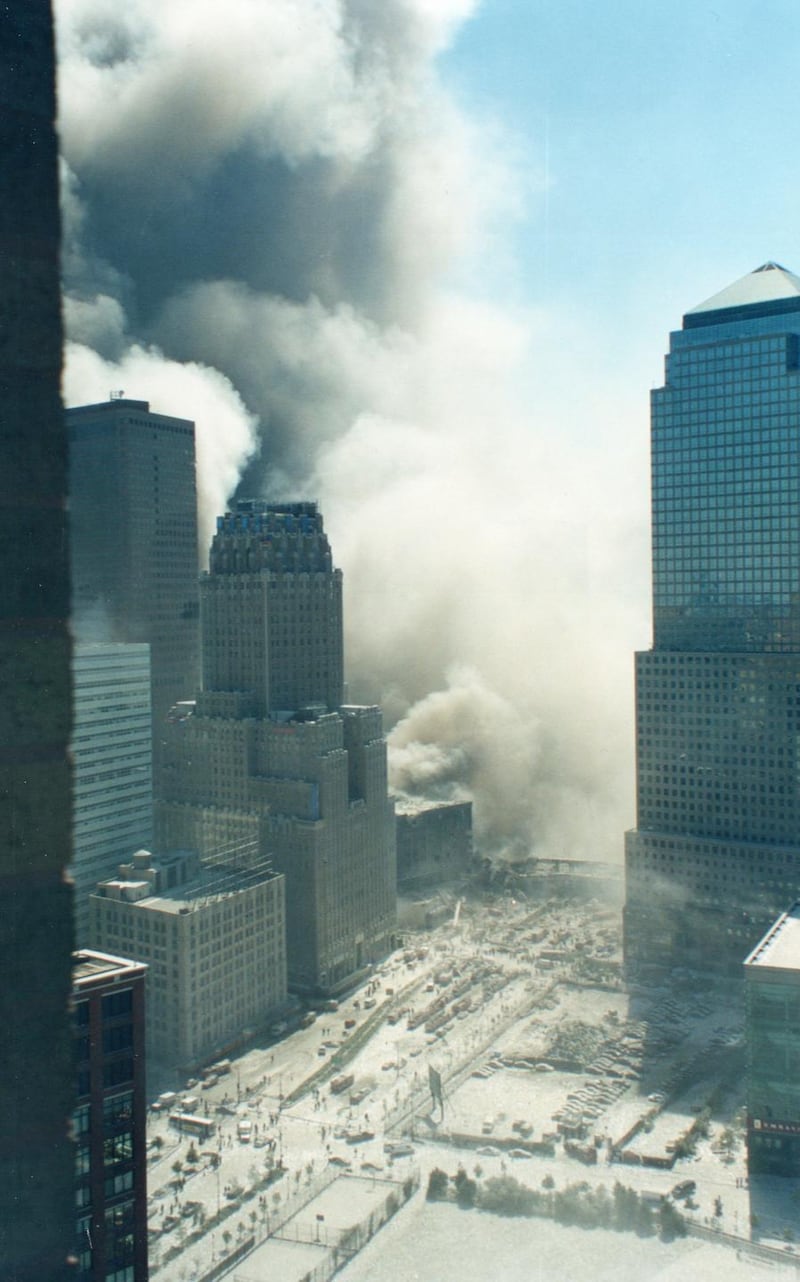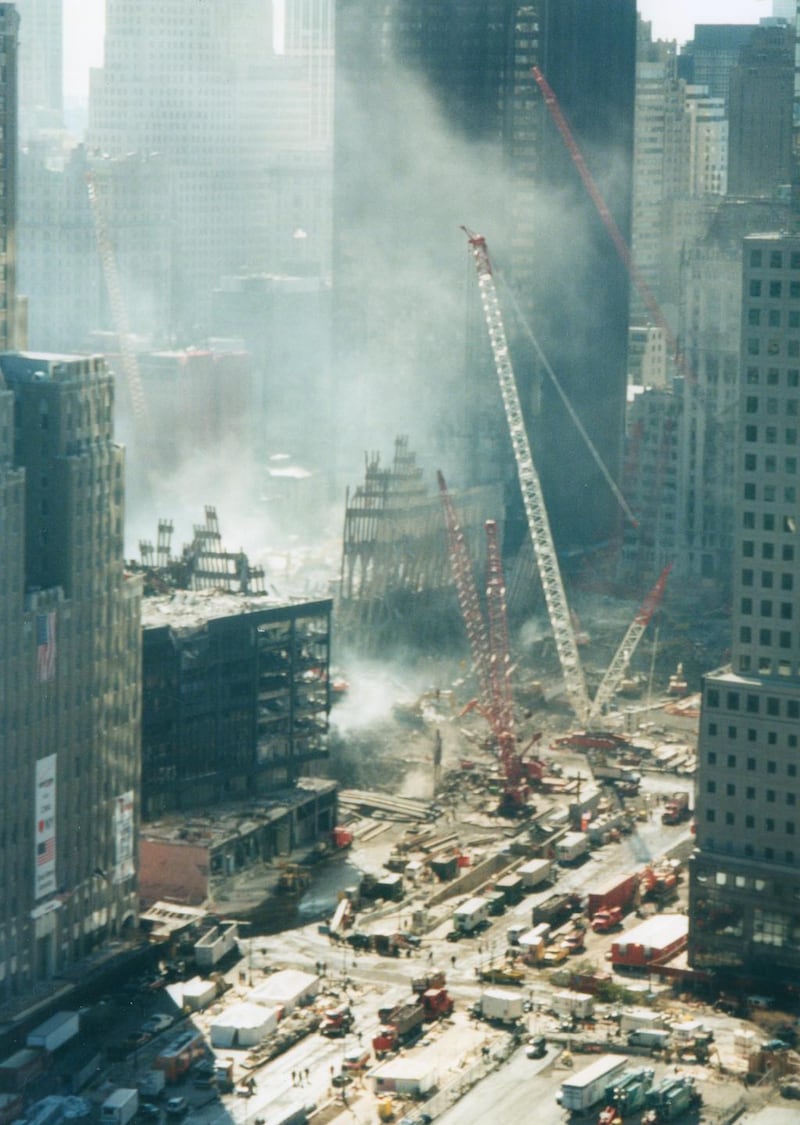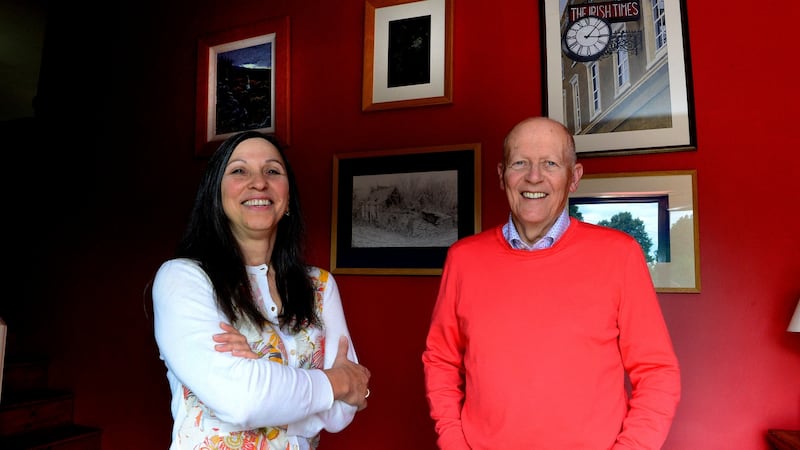The most vivid memory of those who witnessed, close up, the attack on New York’s World Trade Center on September 11th, 2001, is of people falling to their death from the burning Twin Towers onto the streets below.
I was working in my office three blocks away that morning when the first plane struck the North Tower at 8.45am. The top part was instantly consumed by fire.
When I raced over to the scene, people were falling from a great height onto Greenwich Street. The sound of the impact was sickening. The sight was something I would like to erase from my memory.
It became fashionable for celebrities to dine on seared scallops at pavement tables within sight of the smoking rubble which blocked the end of the street
Back in my office, and looking through binoculars from my 42nd-storey room, I focused on one office worker at a window of the North Tower. He was standing on a ledge waving a white cloth as black smoke poured from the row of narrow, vestry-like windows beside him. He was in his 30s, I would say, and a little overweight.
I felt irrationally that he was looking at me and appealing for help and I could do nothing. It left a lasting feeling of guilt in the pit of my stomach, an awful sense of inadequacy in the face of catastrophe.

At 10.28am the 110-storey tower imploded floor by floor, spewing out clouds of debris. The man descended into the abyss as if on an elevator. A vast, yellow-brown cloud billowed out over downtown. It left a thick layer of ash and dust and covered the broken bodies on Vesey Street like a shroud. Shredded paper floated in the air like snow.
Some 200 people fell to their deaths from the towers, as the intense heat and fumes and the shuddering of the building forced them into the void.
My lasting recollections of this terrible day, when militants from al-Qaeda flew hijacked planes into both towers of the World Trade Center, are framed by my experience of life in the vicinity of the towers before and afterwards.
The World Trade Center was not just the workplace of 50,000 bankers, traders, shippers, brokers, insurance agents, lawyers, secretaries and cleaners. It was a complex of seven buildings on 16 acres with its own zip code, 10048.

Directly beneath was an underground complex with shops selling clothing, jewellery, kitchenware and stationery, along with a chocolatier, a hot bread bakery, a delicatessen, a shoe-repair kiosk, several cafes and restaurants, three hairdressers, and booking agencies for air travel and Broadway theatres.
Most weekends there were concert performances in the plaza between the towers and orchid displays and art exhibitions on the wide glass-enclosed pedestrian bridge stretching from the towers across West Side Highway.
This was our village, the beating heart of downtown Manhattan and the focal point of our daily lives. It was obliterated on 9/11, along with a Borders bookstore, an Embassy Suites hotel, St Nicholas’s Greek Orthodox Church, a vast Turkish deli, an Amish market and an adjacent 47-storey tower which burned all day before collapsing. So the attacks at the World Trade Center, which killed 2,763 people, some of whom I knew, were personal in many respects.
I have a vivid memory of exhausted firemen standing along Greenwich Street that afternoon, coated from head to foot in dust, gazing at the remains of the towers where, we would learn later, 343 of their comrades had died.
That evening residents were ordered to leave the “crime scene” of Ground Zero. Walking uptown from the gigantic pyre, we found people dining at open-air wine bars in Greenwich Village, as if nothing had happened.
We grabbed a bite at a tiny restaurant called The Place. Actor Helen Hunt was at the next table. A brief fight broke out between a waiter and another diner. Chairs and bottles flew through the air and Helen Hunt hightailed it up the street. Someone shouted: "Call the police."
There were other surreal scenes. Some fashionable restaurants on Greenwich Street were able to reopen after two weeks and my wife Zhanna and I treated ourselves to a meal in Robert De Niro's Tribeca Grill. We ate in a near-empty diningroom. A week later Tribeca Grill was booked out, with Bill Clinton and comedian Jerry Seinfeld among the customers showing support for the devastated local businesses.
Now 32 years later, it is happening again. History has repeated itself, just with different actors
It became fashionable for celebrities to dine on seared scallops at pavement tables within sight of the smoking rubble which blocked the end of the street.
Sometime after 9/11, Paddy Moloney of The Chieftains came to New York and I took him to Ground Zero, where he wished to play a lament for the dead on his tin whistle. The haunting strains of Táimse Im' Chodladh (whose lyrics include "I am asleep and do not wake me") and Dóchas (Hope) were almost drowned out in the harsh cacophony from mechanical diggers and cranes.
Many people moved away from Lower Manhattan after the attack, partly because it was too much to bear. Ground Zero became a scene of endless horror. At night it was like Dante’s Inferno, with dazzling stadium lights silhouetting twisted girders and sparks cascading down from the acetylene torches of ironworkers to mingle with acrid black smoke. Tall cranes swung back and forth and lines of diggers with clam-shell grabbers dumped twisted mesh, crushed glass and pulverised concrete onto trucks, which day and night unloaded the contents with great thumps and bangs into a fleet of barges on the Hudson river.

All the while specialists in white protective suits picked through the debris for human remains. Sometimes late at night, even three or four months afterwards, we would glance out and see a corpse or a body part being carried out in a coffin, with police and firemen lining the exit ramp to salute.
There were days when the breeze carried sticky dust and foul odours through our windows. We were not aware how toxic it was until two years later when Christine Todd Whitman, the then head of the Environmental Protection Agency, admitted her officials lied about the danger of dust from asbestos, saying "we didn't want to scare people" into deserting Wall Street.
The attack on the United States provoked a surge of understandable fear and genuine patriotism. The Bush White House capitalised by invading Iraq to topple Saddam Hussein, based on the lie that he had weapons of mass destruction ready to deploy. Even liberal newspaper columnists bought into the myth, writing articles along the lines of "I can't believe I'm a hawk". But tens of thousands of New Yorkers demonstrated against invading Iraq.
France refused to back America's wars, and popular resentment was stirred up, sometimes in silly ways: French fries were banned and French wines poured away. I reported on a Casablanca-like scene in a French restaurant in New York in which a group of diners bellowed out God Bless America, prompting another table to respond with the Marseillaise.

When the United States and allies occupied Afghanistan some months after 9/11, I recalled lessons learned when on assignment there as a foreign correspondent during the 1979-89 Soviet occupation.
In 1980, in the mountains near Kandahar, an educated, English-speaking mujahideen commander, Zafaruddin Khan, told me that his goal was not just to get rid of the Russians but to create a pure Islamic state from which all disbelievers would be expelled.
The mujahideen (later the Taliban) were the forces which the US began supplying with weapons and money in pursuit of their cold war enmity with the USSR.
Near the end of the Soviet occupation, in the Afghan city of Khost, a schoolteacher told me that if the American-armed mujahideen, at that moment shelling the city, achieved victory, she would have to close the girls’ school.
And that is what took place when the Soviet army withdrew from Afghanistan in 1989. Now 32 years later, it is happening again. History has repeated itself, just with different actors.
How ironic that the US war in Afghanistan, which began with the sight of people falling from the Twin Towers, should end with the images of Afghans tumbling to their death after clinging as long as they could to a military aircraft, during the chaotic evacuation from the country the US tried, and failed, to control in the years since 9/11.
Conor O’Clery was the Irish Times international business editor, based in New York, from 2001 to 2005


















